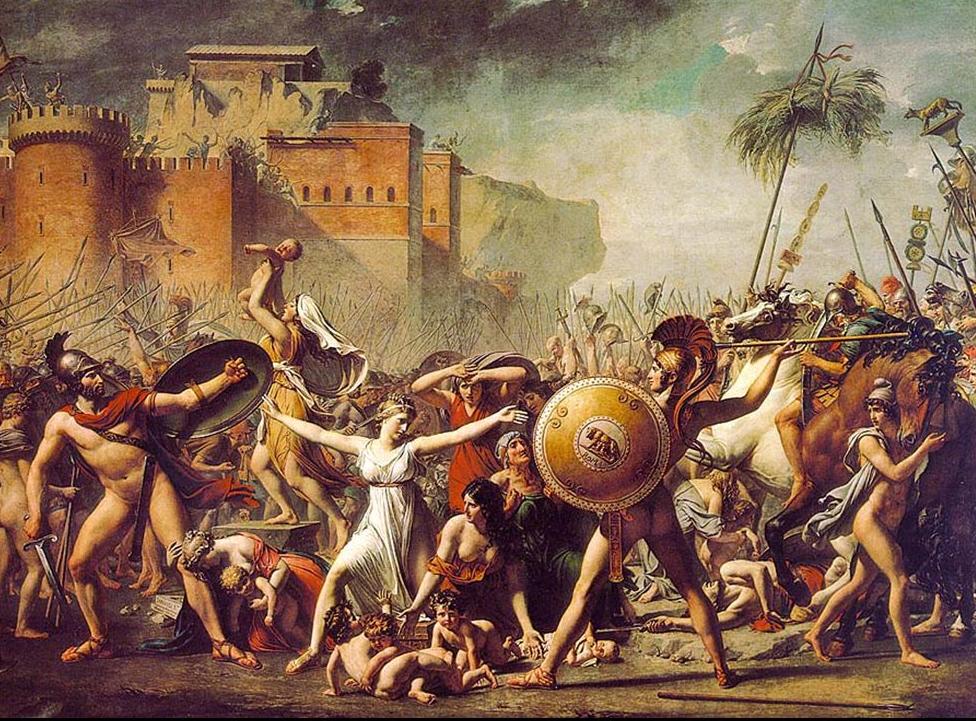
Ancient Italic Peoples: The Sabines (5th-3rd Centuries BC)

Figure 1.-'-The Intervention of the Sabine Women' (1799) is one of French painter Jacques-Louis David's historical work. It depicts a legendary episode in Roman history-- concerning the abduction of the Sabine women by the founding generation of Rome. This legend itself is important becuase it means that not only did the Sabines influence many Roman institutions but the Romans saw the Sabines as common blood. David did not paint the Rape of the Sabine Women, rather the painting depicts the kidnapped women intervening to reconcile the warring Sabines and Romans. At he center is Romulus's wife Hersilia — the daughter of Titus Tatius, leader of the Sabines. She is interposing herself and hr babies between her husband and her father. A striking Romulus prepares to strike a hhesitating Tatius with his spear, but hesitates. Soldiers around them are already sheathing their swords. David was in prison at the time, a suporter of the disgraced Robespierre who had ovrseen the Revolutuinary terror. Art historians see it has David's plea to reconcile the warring factions of the Revolution.
|
|
The Sabines were an ancient Italic tribe located in the mountainous country east of the Tiber River, meaning east of Rome. They were known for their religious practices and beliefs. They are believed to have influenced Rome at its early developmental phase. Some Roman institutions were said to have originiated with them. All we know about them comes from Greek and Roman sources. It is not clear, however, ho much of hat is legend and how much is actualy history. Plutarch writes that Romulus, the legendary founder of Rome, invited the Sabines to a feast and then carried off (meaning raped) their women. While this is legendary, the Sabines must have interacted with the Romans from the city's earlies days. There is a legend thst the Sabines conquered the city (early 5th century BC). This seems likely. There must hsve been many confrontations before the Romans gained a substantial victory (449 BC). At that point they virtually disappear from history. Roman historians subsequently report that the Sabines were conquered, but granted civitas (sine suffragio) (290 BC). They were granted received full Roman citizenship (268 BC). The Sabines probably spoke Oscan. No inscription of any kind has survived of their dialect. Quite a number of words have been attributed to them by Latin writers. The Romans blieve that the Sabines were probably the origin of the Samnite tribes that opposed the Romans for several centuries souuth of Rome. Many classical scholars believe thst it is creditable.
CIH

Navigate the HBC Italian pages:
[Return to the Main pre-Roman Italian history page]
[Return to the Main Roman war page]
[Return to the Main ancient history page]
[Return to the Main Itlalian page]
[Return to the Main European history page]
[Italian school uniforms]
[Italian youth groups]
[Italian choirs]
[Italian movies]
[Italian royalty]
Navigate the Children in History Website:
[About Us]
[Introduction]
[Biographies]
[Chronology]
[Climatology]
[Clothing]
[Disease and Health]
[Economics]
[Freedom]
[Geography]
[History]
[Human Nature]
[Ideology]
[Law]
[Nationalism]
[Presidents]
[Religion]
[Royalty]
[Science]
[Social Class]
[Bibliographies]
[Contributions]
[FAQs]
[Glossaries]
[Images]
[Links]
[Registration]
[Tools]
[Children in History Home]
Created: 11:07 PM 7/9/2018
Last updated: 11:07 PM 7/9/2018



